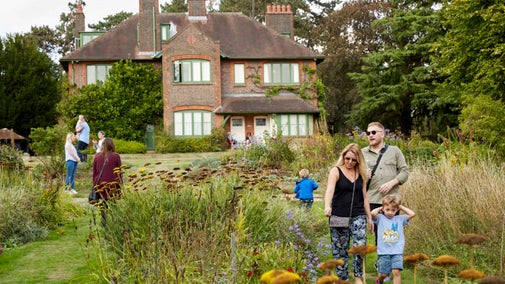1856
The birth of Shaw
George Bernard Shaw is born in Dublin on 26 July 1856.

George Bernard Shaw was a famous playwright and activist during the late 19th and early 20th centuries. From inner-city Dublin to Hertfordshire, discover his story and that of Shaw's Corner – the place he called home.
George Bernard Shaw was an Irish playwright and political activist who used wit and satire to challenge social and political inequalities over a long and productive life. He was hugely prolific; he wrote nearly 60 plays, over 250,000 letters and countless articles and pamphlets. During his lifetime he was one of the most photographed and quoted men in the world – his words and opinions are still deeply relevant today.
George Bernard Shaw was born on 26 July 1856 in the Dublin suburbs, the youngest son of the unhappily married and down-at-heel grain merchant George Carr Shaw and Lucinca Elizabeth Gurly.
From William Morris to Danny Kaye, via T.E. Lawrence and Virginia Woolf, Shaw was a deeply influential friend and supporter of poets, painters and playwrights, adventurers, actors and explorers.
1856
George Bernard Shaw is born in Dublin on 26 July 1856.
George Bernard Shaw was born into a lower-middle class home in Dublin in 1856, but by the early 1900s had grown to become a successful playwright, and one of the most famous men in the world.
Witnessing poverty in Ireland inspired him to champion equality for all, fuelled by a belief that inequality of any kind was neither inevitable nor acceptable.
It is understood that Shaw’s need to spread his ideas widely overcame a natural shyness, and he became well known as a celebrity of his time and a serious thinker committed to questioning the status quo in society.

The playwright moved to Shaw’s Corner in 1906 with his wife, Charlotte Payne-Townshend. A suffragist, philanthropist and translator, Charlotte shared Shaw’s ideals and devoted much of her time to the struggle for women’s rights.
The pair were committed socialists and part of the Fabian Society, whose members believed that capitalism created an unequal society.
Shaw believed in equality of opportunity and a fair division of land and wealth. Unlike Marx, Shaw believed that socialism would win out over time, rather than by violent revolution.
Charlotte was a key member of the Fabian Women’s Group and lobbied widely for suffrage.
As well as campaigning for the right for women to vote, Shaw insisted that women be given the opportunity to take centre stage to represent their own views during the suffrage movement.
Many of Shaw's plays explore women's position in society, such as Pygmalion and Mrs Warren's Profession. These had an impact on the Pankhurst family, a name famously associated with the suffragette movement.
In 1903, Emmeline Pankhurst and her daughters founded the Women’s Social and Political Union (WSPU), the leading militant organisation campaigning for women’s suffrage in the United Kingdom.
Both Shaw and the WSPU shared the view that the suffrage movement would have to become radical and militant if it was going to be effective. In 1906, Bernard Shaw told an American journalist that suffragettes should 'shoot, kill, maim, destroy – until they are given the vote.'

Shaw’s Corner was the home of George Bernard Shaw and his wife, Charlotte, from 1906 to 1950. It was originally built as the New Rectory for Ayot St Lawrence by the Church of England in 1902. The house was designed in the fashionable Arts and Crafts style with stained-glass windows and hearts cut into the banisters.
The house was not used as a rectory for long, and was offered for rent by the Church of England in 1906. The Shaws had just left a house in nearby Welwyn and were in 'the agonies of house hunting' as Shaw wrote to H.G. Wells, when they found the house that would become their most permanent home.
In 1920 the couple decided to buy it outright. Around the same time the name of the house officially changed from The New Rectory to Shaw’s Corner, which the locals had started calling the house shortly after they moved in.
1902: The house is built by local church architects
1906: The Shaws start to rent the house, fully furnished, from the Church of England
1915: Shaw helps villagers clear the roads after a terrible storm giving him acceptance by the local community. Prior to this villagers had reservations about their famous neighbour
1920: The Shaws buy the house for £6,332
1923: The garden is extended, as Shaw buys an extra strip of land to the west and south
1944: Shaw bequeaths the property to the National Trust after Charlotte's death
1950: Shaw dies in the Dining Room on 2 November
1951: The house opens to the public on 17 March

Find out when Shaw's Corner is open, how to get here, things to see and do and more.

Discover more about the collection at Shaw’s Corner. From the bust of Shaw sculpted by Auguste Rodin to a Best Screenplay Oscar for the film adaptation of Pygmalion and the daily tools of a writer, the collection at Shaw's Corner is full of treasures. The bust by Rodin is now one of the National Trust’s 125 treasures.

Discover Shaw’s Corner, the home of playwright, George Bernard Shaw. Explore the beautiful Arts and Crafts interiors and find fascinating links with the past.

The garden at Shaw’s Corner extends to 3.5 acres and is in a conservation area. Kept as Shaw liked it, the garden looks just the same today.

Shaw's Corner is open for pre-booked house tours only. Find all the information and to book your visit here. Visits to the garden only do not require pre-booking.

Learn about people from the past, discover remarkable works of art and brush up on your knowledge of architecture and gardens.